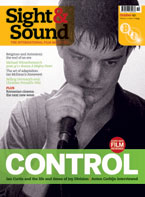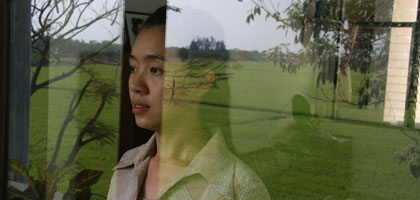
In Loving Memory
Film of the Month: Syndromes and a Century

Apichatpong Weerasethakul's new two-part film may sound more like an art installation than cinema, but the Thai director's resonant meditation on love and misunderstanding is a pleasure to watch, says Tony Rayns
Considering the challenges it poses, Syndromes and a Century is an exceptionally easy and pleasurable watch. Apichatpong Weerasethakul's earlier features Blissfully Yours (2002) and Tropical Malady (2004) weren't exactly hard slogs either, but both had more or less linear narratives. Although it's scripted and acted, Syndromes has no narrative as such: it offers a series of vignettes, some of them seen twice in substantially different versions, with no obvious causal logic or storytelling flow. It's not even a Borges-like 'Garden of Forking Paths', since the repetitions and variations don't affect lives or outcomes. At first sight, the assemblage of episodes and incidents seems random, although the tone darkens decisively in the closing stages. The cumulative effect, however, is liberating, and not just because so many of the images and actors are so beautiful.
Like Blissfully Yours and Tropical Malady, this is essentially a film in two halves; Apichatpong says he thinks this will be the last time he uses such a structure to explore dualities. Both halves are set in hospitals - the first rural and vaguely old-fashioned, the second urban and high-tech but with a hellish basement - and both are loosely organised around individual doctors: Toey (female) in the first half, Nohng (male) in the second. Nohng's job interview for his post on the staff, conducted by Toey and loaded with psychological-profile questions rather than medical ones, opens both halves and thereby demarcates the break at the centre of the film. Aside from the difference in setting - lush, green landscapes outside the windows of one hospital and high-rise towers outside the other - the two halves are distinguished by their quality of light. The first takes place largely in natural light (and dark), whereas the second is lit mostly by fluorescent-tube ceiling lights.
The more you pinpoint the film's central dualities - female/male, country/city, sunlight/electric light, then/now and so on - the more it starts to sound like one of Apichatpong's gallery pieces or installations: an art object rather than a movie. The paradox is that it plays just fine in the cinema. This is partly down to the film's humour and the rhythms of its pacing and editing, which make it richer and more rewarding at a purely sensual level than the average mainstream movie. But it's also because the 'syndrome' that most preoccupies Apichatpong is love. Or, more precisely, the stuttering, shambling awkwardness of attempts to express love, as against the way a single word or gesture can be enough to open up a chasm in an existing relationship. Towards the end of the second half, for instance, Dr Nohng is seen with his girlfriend Joy, who urges him to apply for a post at a new hospital currently under construction. She brandishes a picture of the building site to impress him, and Apichatpong's close-up of the photo says all that needs to be said about the fact that the relationship has no future.
The only relationship in the film that does seem to be going somewhere is the one between a dentist, Dr Ple, and his patient, the Buddhist monk Sakda. It's the film's main subplot, in that it involves neither Toey nor Nohng. Ple is clearly infatuated, and sings to the slightly alarmed monk while prodding his molars; Sakda has in a sense asked for it by admitting that he really wanted to be a DJ. Ple later performs in public at a charity event and gives a pre-release copy of his first CD to Sakda, who doesn't own a CD player. Then Sakda invites Ple to follow him somewhere but suddenly disappears - just like the country boy in Tropical Malady, who (not at all coincidentally) was also played by Sakda Kaewbuadee. This, of course, suggests that any future relationship between them will be thrillingly risky.
Nohng doesn't seem especially lovelorn, but the absence of romance is clearly a big issue in Toey's life. She has a nerdy suitor (played by Apichatpong's poster designer) who's forever waiting for her and offering unsuitable gifts; she deflects his dogged attentions by chatting to him about a dishy man she recently met, the orchid-collector Noom. This triggers a series of brief flashbacks to Toey's conversations with Noom and his designer friend Pa Jane in which Noom deflects Toey's obvious interest by seeking her advice on approaching someone he fancies; she responds to the rebuttal by asking, to his embarrassment, if it's a man or a woman he's chasing.
At this point there's a clear sense that Apichatpong is constructing an emotional hall of mirrors, but the film's panorama of failed romantic overtures enters another dimension entirely in the second half when Toey's words are directly echoed by Nohng in a completely different context. Nohng is trying to talk to a disturbed and incipiently violent young patient who has suffered neural damage from carbon-monoxide poisoning. He gets no answer to a question about the boy's love life, and so asks how the boy thinks he will be reincarnated: as a man or as a woman? Gender, in other words, has different resonances in the Buddhist scheme of things.
This is one of several unpredictable echoes that bounce between one half of the film and the other. In the first half, for instance, an anecdote about greedy farmers told by Pa Jane leads to an image of a total eclipse of the sun. This is paralleled in the second half by the image of the dark orb of an extractor funnel sucking up noxious fumes in the hospital's basement; Apichatpong's camera tracks around and towards it, producing a vision scarier than anything in Hostel. This parallel has no more precise meaning than anything else in the movie. But it's certainly minatory.
Actually, Apichatpong provides a key to some of the film's mysteries in his recent interviews and statements. Toey and Nohng are based on his mother and father, both of whom were doctors, and the film's episodes are drawn in part from what they told him about their lives and experiences before they met and married. (Hence, of course, the variant versions of some scenes: two accounts, two points of view.) Apichatpong has conflated these 'inherited' memories with his own recollections of growing up in the country hospital where his parents worked, plus other ideas and stories encountered during production. Knowing this, however, explains nothing of significance and does nothing to defuse the film's oneiric power.
The second half climaxes with a vision of hell. Like a parody of the ending of Antonioni's L'eclisse, the camera prowls through the empty basement of the hospital: stark lighting, sinister fumes, a glimpse of unexplained welding, threatening noises off - all manifestly a lot worse than whatever awaits Sakda and Ple at the end of the first half. But just as all hope of human happiness and emotional/ecological fulfilment seems to be snuffed out, Apichatpong goes into an upbeat coda. The anonymous joggers in tracksuits who pop up now and again in the second half convene in the hospital grounds and launch into a mass callisthenics work-out, accompanied by an irresistibly bouncy pop song. Things may look grim, Apichatpong suggests, especially in our big cities, but we adapt and survive. No moralising, no point-scoring, no clear-cut meanings. Just an exuberant display of energy - and a reminder that the director of Blissfully Yours and Tropical Malady is a sucker for sappy Thai pop hits.
